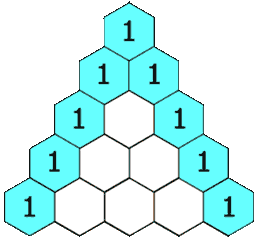118. Pascal's Triangle
Given a non-negative integer numRows, generate the first numRows of Pascal's triangle.

In Pascal's triangle, each number is the sum of the two numbers directly above it.
Example:
Input: 5
Output:
[
[1],
[1,1],
[1,2,1],
[1,3,3,1],
[1,4,6,4,1]
]
1 public class Solution { 2 public List<List<Integer>> generate(int numRows) { 3 List<List<Integer>> listAll = new ArrayList<>(); 4 if (numRows <= 0) return listAll; 5 for (int i = 0; i < numRows; i++) { 6 List<Integer> list = new ArrayList<>(); 7 list.add(1); 8 if (i != 0) { 9 List<Integer> prevList = listAll.get(i - 1); 10 for (int j = 1; j < prevList.size(); j++) { 11 list.add(prevList.get(j-1) + prevList.get(j)); 12 } 13 list.add(1); 14 } 15 listAll.add(list); 16 } 17 return listAll; 18 } 19 }


